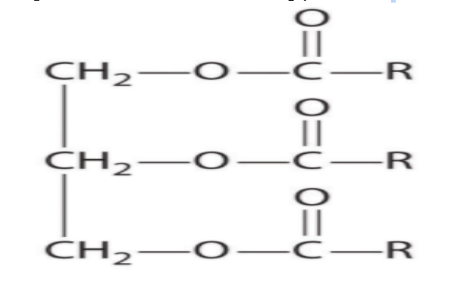
What is the organic molecule that stores the most energy called, and what is its structure
Answer
441.9k+ views
Hint: First we know what an organic compound is. Then write the name of the organic molecule that stores most energy, and writes its general structure.
Complete step by step answer:
A compound is a substance that consists of two or more elements. A compound has a unique composition that is always the same. The smallest particle of a compound is called a molecule.
An organic molecule is a molecule normally found in living systems. Organic molecules are usually composed of carbon atoms in rings or long chains, to which are attached to other atoms of such elements as hydrogen, oxygen, and nitrogen. Some examples of organic molecules are Carbohydrates - Carbohydrates consist only of carbon, hydrogen, and oxygen. They include starches and sugars and play an important role in our daily lives.
The organic molecules that store the most energy are called fats or triglycerides. The animal body uses carbohydrates (glycogen) for medium-term energy storage and fats or triglycerides (lipids) for long-term energy storage. Carbohydrates store about
The general structure of fats or triglycerides is

Note:
Note that fats store more than twice as much energy as glycogen. Among the various types of organic compounds, four major categories are found in all living things are carbohydrates, lipids, proteins, and nucleic acids.
Complete step by step answer:
A compound is a substance that consists of two or more elements. A compound has a unique composition that is always the same. The smallest particle of a compound is called a molecule.
An organic molecule is a molecule normally found in living systems. Organic molecules are usually composed of carbon atoms in rings or long chains, to which are attached to other atoms of such elements as hydrogen, oxygen, and nitrogen. Some examples of organic molecules are Carbohydrates - Carbohydrates consist only of carbon, hydrogen, and oxygen. They include starches and sugars and play an important role in our daily lives.
The organic molecules that store the most energy are called fats or triglycerides. The animal body uses carbohydrates (glycogen) for medium-term energy storage and fats or triglycerides (lipids) for long-term energy storage. Carbohydrates store about
The general structure of fats or triglycerides is

Note:
Note that fats store more than twice as much energy as glycogen. Among the various types of organic compounds, four major categories are found in all living things are carbohydrates, lipids, proteins, and nucleic acids.
Recently Updated Pages
Master Class 12 Business Studies: Engaging Questions & Answers for Success

Master Class 12 English: Engaging Questions & Answers for Success

Master Class 12 Social Science: Engaging Questions & Answers for Success

Master Class 12 Chemistry: Engaging Questions & Answers for Success

Class 12 Question and Answer - Your Ultimate Solutions Guide

Master Class 11 Economics: Engaging Questions & Answers for Success

Trending doubts
Draw a labelled sketch of the human eye class 12 physics CBSE

a Tabulate the differences in the characteristics of class 12 chemistry CBSE

Which one of the following is a true fish A Jellyfish class 12 biology CBSE

Why is the cell called the structural and functional class 12 biology CBSE

Differentiate between homogeneous and heterogeneous class 12 chemistry CBSE

Write the difference between solid liquid and gas class 12 chemistry CBSE




